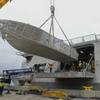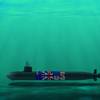By Journalist 1st Class (SW) Robert Keilman, USS Kearsarge Public Affairs
The amphibious assault ship USS Kearsarge’s (LHD 3) deck department had the opportunity to conduct training with an amphibious vehicle July 23 not normally found aboard.
During the daylong training evolution, boatswain’s mates (BM) from the ship’s 2nd division learned how to safely guide nine individual Marine Amphibious Assault Vehicles (AAV) into the ship’s well deck.
AAVs are full-tracked landing vehicles used to transport Marines during amphibious ship-to-shore operations. AAVs have the capacity to carry 21 combat-equipped Marines and 10,000 pounds of cargo. They can travel at speeds up to 30 miles per hour on land, yet moves only six miles per hour in the water.
"The AAV training was an exercise driven by 5th Fleet,” said Chief Boatswain’s Mate (sel.) (SW/AW) Sigarrie Nettles, Kearsarge’s 2nd Division leading petty officer. “Although we don’t work with this type of equipment often, my guys performed as if they’ve been doing it every day.”
Nettles explained that before the training could commence, the BMs had to refresh their knowledge on signaling.
“Normally this ship takes on LCACs (landing craft, air cushion), or on occasions, LCUs (landing craft, utility),” said Boatswain’s Mate 2nd Class (SW) Dominick Tintari, one of Kearsarge’s well deck safety petty officers. “For the AAVs, we had to train ourselves and our people on wand signals. The signals for AAVs are completely different from the LCACs and LCUs.”
In addition to different maneuvering signals, guiding an AAV also requires more manpower.
“AAV maneuvering isn’t a straight shot into the well deck,” said Boatswain’s Mate 2nd Class (SW/AW) John Bradley, another well deck safety petty officer. “You usually have only one guy signaling an LCAC or LCU, but with an AAV, it takes up to three people.”
For the BMs, this marks another experience and another milestone in landing craft handling training.
“One of the reasons why we train with the AAVs is because all boatswain’s mates need to be versatile,” said Tintari. “Now that I’ve participated in AAV well deck operations, I’ve added them to my landing craft tool bag.”
Kearsarge is currently deployed to the Persian Gulf conducting maritime security operations (MSO). MSO set the conditions for security and stability in the maritime environment, as well as complement the counter-terrorism and security efforts of regional nations. MSO deny international terrorists use of the maritime environment as a venue for attack or to transport personnel, weapons or other material.
Subscribe for
Maritime Reporter E-News
Maritime Reporter E-News is the maritime industry's largest circulation and most authoritative ENews Service, delivered to your Email five times per week










